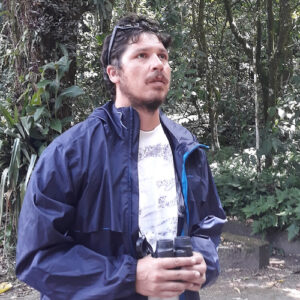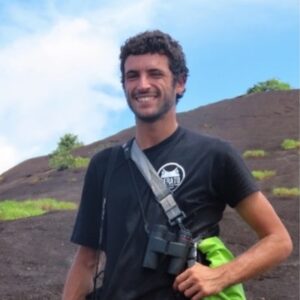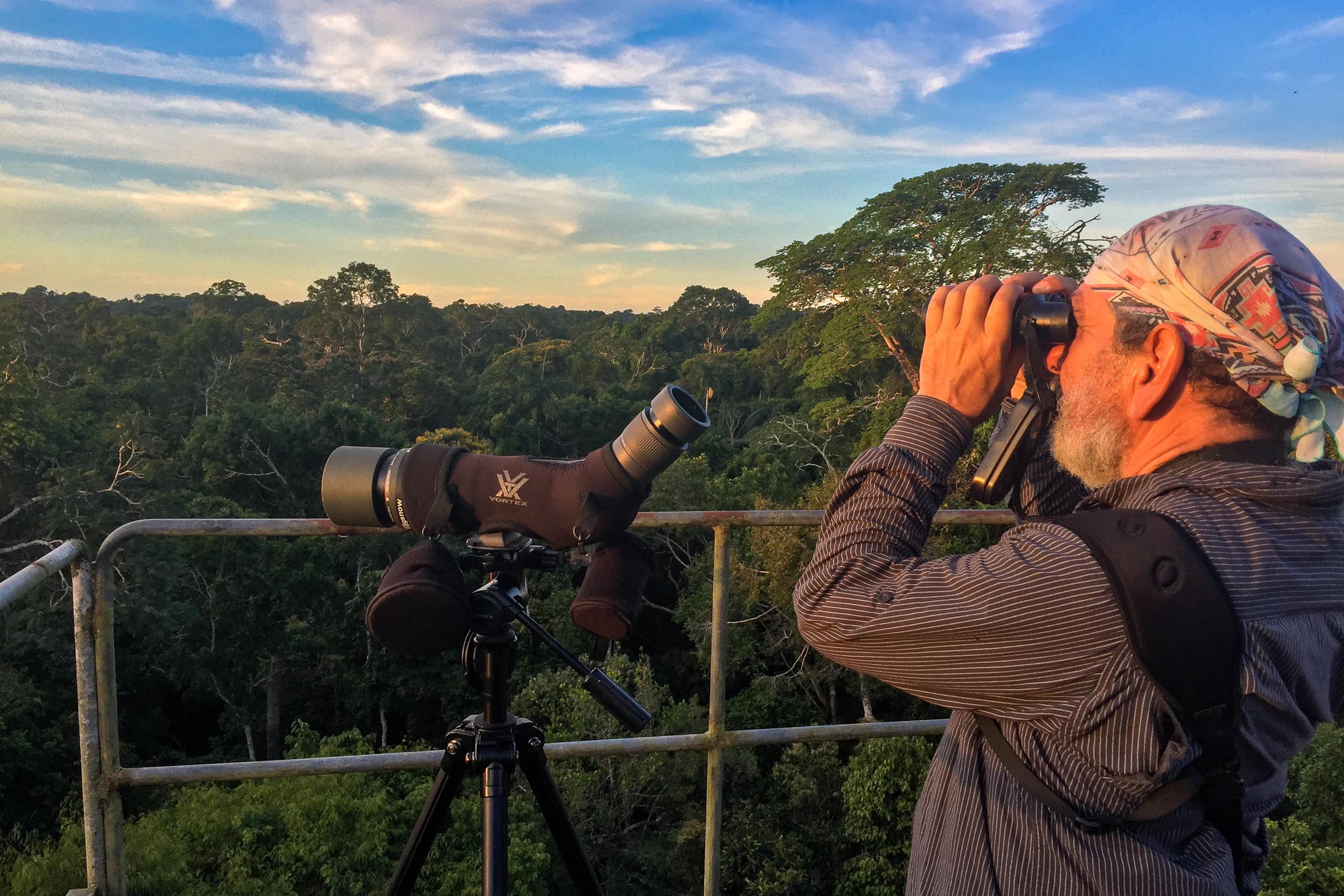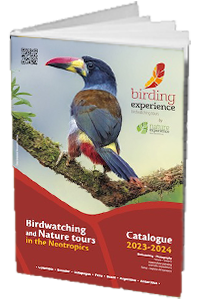Your travel expert
Xavier Amigo
Responsible for naturalist, botanical and ornithological travel. Responsible of fixing and professional contact.

When most people think of Brazil, they think of Carnival, Sugarloaf, and endless beaches, but we think of the Pantanal and the Atlantic forests. Between large wetlands, savannahs, and emerald forests, these two great ecosystems are excellent places to start discovering Brazil. They are also the best places on the continent to observe unique fauna, with over 600 species present.
Your travel expert
Xavier Amigo
Responsible for naturalist, botanical and ornithological travel. Responsible of fixing and professional contact.

After you arrive at the Guarulhos International Airport in Sao Paulo, your guide will welcome you before we head directly to the Congonhos local airport for our internal flight to Mato Grosso province. This will be our gateway into the legendary Pantanal. We’ll have some time to get to know each other while waiting at the airport, and after our 2h30 flight to Cuiaba, our transport will be waiting to take us to the hotel. After such a long journey, you’ll probably want to rest, but those with some energy left can visit the nearby Mae Bonifacia Park with the guide.
Dinner and overnight stay in a country hotel in Cuiaba.
English-speaking welcome and transfer
After breakfast, we board our air-conditioned vehicle for the long drive south. During this journey, we’ll have the chance to go over the tour itinerary and target species in detail and learn a bit more about the history of this immense and diverse country. Once we arrive in Poconé, we will take the northern section of the famous Transpantaneira road. We’ll make our first birding stops along this road and can explore the restaurant garden for some commoner species during the lunch stop. We’ll keep birding the roadside savannah and riverbanks until we reach the end of the Transpantaneira.
Dinner and overnight in a comfortable lodge on the banks of the Cuiabá River.
English-speaking naturalist guide, private transport
Undulated Tinamou, Black-hooded Parakeet, Yellow-collared Macaws, Common Thornbird, Southern Screamer, Plumbeous Ibis, Bare-faced Curassow, Greater Rhea, Whistling Heron, Long-tailed Ground-Dove, Great Rufous Woodcreeper, Planalto Woodcreeper, White Woodpecker, Pale-crested Woodpecker, Red-crested Cardinal, Orange-backed Troupial, Gray-crested Cacholote,, Nacunda Nighthawk, Ferruginous Pygmy-Owl.
This morning, we will board a speedboat on the banks of the Cuiaba River to head to the best viewing areas for our main target: the Jaguar. We’ll spend the day navigating the different rivers, scanning the banks and clay licks. We have a radio communication system between the different boatmen, which maximizes the opportunity to observe this feline, which is so rare elsewhere. The dry season drives the Pantanal Jaguars and their prey to the riverbanks, and it is common to observe these big cats sharing the area with other mammals and reptiles at this time of year. Thankfully, they will often remain in one spot for hours, largely indifferent to our presence, making for some wonderful photo opportunities. We will make the most of these pleasant and biodiverse waterways to add more birds to our list and hopefully observe families of Giant Otters, which are normally easy to spot here. The day’s observations will dictate our return time to the lodge.
Dinner and overnight stay at the same Fazenda.
English-speaking naturalist guide
Today, we’ll take another morning outing, choosing the site based on the species observed the previous day. The rest of the day will be dedicated to exploring the Pantanal. The largest wetland on the planet sees the first seasonal rains arrive at the end of October and the beginning of November. Until then, the lack of water forces all animal species into large mixed congregations along the rivers. In many places, large reptiles live alongside capybaras and waterbirds. Several species of deer cross the swampy expanses where the jaguar and the maned wolf hunt. This phenomenon of seasonal flooding acts as a regulator of the dynamics of animal and plant communities. It’s a fragile balance, surprising and full of life. Once again, we will take the Transpantaneira road to our next accommodation. Although it’s normally a two-hour journey between the two lodges, it often takes much longer since we usually encounter many animals. On arrival at our new accommodation, we will take advantage of the bird feeders to add new species of tanagers, guans, caciques, toucans, and hummingbirds to our list.
Dinner and overnight at the Pousada Rio Claro.
English-speaking naturalist guide, private transport
Red-legged Seriema, Boat-billed Heron, Sungrebe, Sunbittern, Blue-throated Piping-Guan, Green and Amazon kingfisher, Agami Heron, Chestnut-eared Aracari, Solitary Black Cacique, Silver-beaked Tanager, Grayish Saltator, Grayish Baywing, Band-tailed Antbird, Rusty-backed Spinetail, Buff-breasted Wren, Large-billed Antwren, Golden-green Woodpecker, Helmeted Manakin, Flavescent Warbler, Ashy-headed Greenlet, Stripe-necked Tody-Tyrant, Black-banded Owl
Located further south in the Pantanal, the Fazenda de Rio Claro has redirected its economic activity towards tourism and conservation. Numerous trails lead through the gallery forest areas, home to unique vegetation, many understorey birds, and some mammals, including several primates. From the lodge, we will also board our motorboats to explore the bends and curves of the Claro River and discover many aquatic species. We will walk along the Monkey Trail by the riverbank to find difficult species such as the Common Potoo, several antbirds, and flycatchers. We will make the short trip to our new lodge in the afternoon.
Dinner and overnight in Santa Tereza.
English-speaking naturalist guide, private transport
Undulated Tinamou, Roseate Spoonbills, Zigzag herons, Pygmy Kingfisher, Chestnut-bellied Guan, White-fronted and Pale-crested Woodpeckers, White-lored and Cinereous-breasted Spinetails, Planalto Slaty Antshrike, Subtropical Doradito, Red-billed Scythebill, Flavescent Warbler, Moustached and Fawn-breasted Wrens, Purplish Jay, Nanday Parakeets, Saffron Finch and Chestnut-bellied Guan. Helmeted Manakin, Stripe-necked TodyTyrant, Plain Inezia, Flavescent Warbler, Large-billed Antwren, Pale-crested Woodpecker, White-eyed Attila, Rusty-fronted Tody-Flycatcher, Forest Elaenia, Moustached Wren, Golden-green Woodpecker, Rufous-tailed Jacamar and White-lored Spinetail, Mottled Owl, Black-banded Owl
Located on the banks of the Pixaim River, between Cerrado and riparian vegetation, this private reserve is entirely dedicated to conservation and tourism. These 360 hectares are home to, in addition to 360 species of birds, a large number of mammals, including the giant otter, caiman, capibara, several species of primate, and the rare Ocelot and the mysterious Tapir. The trails in the reserve grant us privileged access to key observation sites, including the observation tower and the Pixaim River. After a long day of birding and mammal watching, we continue north to our last lodge. On our first night walk after dinner, we will try to observe owls, nightjars, and potoos.
Dinner and night in a charming hotel.
English-speaking naturalist guide, private transport
King Vulture, Chaco Chachalaca, Rufous Hornero, Gray-crested Cachalote, Amazon Kingfishers, Toco Toucans, Yellow-billed and Red-crested Cardinals, Purplish Jay, Orange-backed Troupial, Bay-wings, Grayish Saltator, Picazuro Pigeon, Long-tailed Ground-Doves, Chestnut-eared Aracaris, Campo Flickers, Vermilion Flycatchers, White-rumped Monjitas, Bare-faced Curassows, Hyacinth Macaw, Chotoy Spinetail, Helmeted Manakin, Blue-crowned Trogon, White-wedged Piculet, Mato Grosso and Band-tailed Antbird, Large-billed Antwren, Greater Thornbirds, Fawn-breasted Wren, Capped Heron, Green Ibis, Wood Stork, Osprey, Southern Caracara, Giant Wood-rail, Green-and-rufous Kingfisher.
The different woodland habitats, open vegetation areas, and many special observation facilities on this farm-reserve allow for the most accessible and special wildlife encounters in this region of the northern Pantanal. We will combine day and night walks, explore on a safari vehicle, climb the observation towers, and visit the different ecosystems of this conservation area: swamps, savannahs, riparian vegetation, gallery forest, flooded pastures, and more. We will also be on the trail of some of South America’s most emblematic mammals: the Giant Armadillo, Crab-eating Fox, Giant Anteater, and South American Tapir.
Dinner and night at the same Fazenda.
English-speaking naturalist guide, private transport
Black-collared Hawk, Hyacinth Macaw, Blue-fronted Parrot, Toco Toucan, Yellow-billed Cardinals, Chestnut-bellied Guan, White-face Ibis, Jabiru, Maguari Stork, Narrow-billed Woodcreeper, Mato Grosso Antbird, White-lored Spinetail, Scarlet-hooded Blackbird , Rusty-collared Seedeater, Chotoy Spinetail, Suiriri Flycatcher, Guira Cuckoo, Band-tailed Nighthawks Spot-tailed Nightjar, Pauraque
We will also explore other ecosystems, such as gallery forest, which punctuate the landscapes of the flooded savannah. Another short drive up the Transpantaneira road will be our final opportunity to add new species to our list and our photography portfolio. Along this red dirt road, we will look for waterbirds, raptors, and our last mammals and reptiles. We will arrive in the late afternoon near the airport in Cuiaba, where we will spend the night. If the weather allows, we can rest by the swimming pool to recharge our batteries for the second part of the trip.
Dinner and overnight stay in Hotel Fazenda in Cuiaba.
English-speaking naturalist guide, private transport
Maguari Stork, Black-collared Hawks, Streamer-tailed Tyrants, Scarlet-headed Blackbird, White-naped Xenopsaris, King Vulture, Cinereous-breasted Spinetail, Golden-collared Macaw, Boat-billed Heron, White-wedged Piculet, White-tailed Goldenthroat, Sungrebe, Pied Lapwing, Yellow-billed, Large-billed Terns, Black Skimmer, Greater Ani, Anhinga, Gray-necked Wood-Rail, Sungrebes, Blue-and-yellow Macaw
After breakfast, we transfer to Cuiabá airport for our flight to Rio de Janeiro. After a stopover in Brasilia and a two-and-a-half-hour flight, we will land at Santos airport to head immediately to our new observation area, the Brazilian Atlantic forests, which are the most critical endemic hot spot in the country. During the next few days, we will explore two lodges of ornithological importance, allowing us to see as many species as possible without a strenuous effort by visiting feeders and taking short forest walks. After a two-hour drive to the northeast, we will enter the conservation area of the REGUA Reserve. We will spend the rest of the day exploring the various feeding sites around the lodge, with the possibility of a night walk after dinner.
Dinner and overnight at the lodge.
English-speaking naturalist guide, private transport
Brazilian Teal, Masked Duck, Grey-headed Kite, Savanna Hawk, Limpkin, Yellow-chinned Spinetail, White-headed Marsh Tyrant, Yellowish Pipit, Chestnut-capped Blackbird, Reddish Hermit, White-chinned Sapphire, Rufous-capped Motmot, Rufous-tailed Jacamar, Crescent-chested Puffbird, Yellow-throated Woodpecker, Chestnut-backed Antshrike, White-flanked Antwren, Unicolored Antwren, Brazilian Laniisoma (Shrike-like Cotinga), Long-billed Wren. Tawny-browed Owl, Common Potoo, Common Pauraque, Scissor-tailed Nightjar.
The REGUA project conserves more than 550 hectares of Atlantic Forest along the Guapiaçu River watershed. Here, 470 species of birds have been recorded, including 62 national endemics. Even for those with previous birding experience in the Neotropics, the vast majority of species will be new here. This is due to the isolation of this semi-mountainous coastal region. Endemic often means fragile; sadly, only 7% of the original Brazilian Atlantic forest cover remains today. The conservation work in this reserve is unique and makes it well worth the visit. Depending on the weather conditions, we can visit several trails, including the Brown Trail, our first immersion in reclaimed secondary forest—an easy trail of lowland forest (50m) with streams and sparse vegetation.
Dinner and overnight at the same lodge.
English-speaking naturalist guide, private transport
Tataupa Tinamou, Maroon-bellied Parakeet, White-chinned Sapphire, Rufous-capped Motmot, Rufous-tailed Jacamar, Channel-billed Toucan, Yellow-eared Woodpecker, Blond-crested Woodpecker, White-flanked Antwren, Sooretama Slaty-Antshrike, White-bearded Manakin, Shrike-like Cotinga, Green-backed Becard, Southern Antpipit, Yellow-breasted Flycatcher, Eye-ringed Tody-Tyrant, Long-billed Wren, Brazilian Tanager, Black-goggled Tanager, Black-legged Dacnis, Spot-tailed Nightjar, Barn Owl, Black-banded Owl, Tawny-browed Owl,
Early in the morning, we head to a new birding area. After a 30-minute drive, we will take the Red Trail, which leads to the higher areas of primary and elfin forest (500 masl). The topography of this trail is more complex but allows access to upper elevations and, therefore, entirely different species from the lower areas. The mountain slopes will also facilitate observation, with the canopy often at eye level, giving us a better shot at spotting certain localized species and offering stunning panoramic views of the Serra dos Organos massif. Then, we’ll return to the lowlands to collect our bags and set off for our new accommodation.
Dinner and overnight in a charming Eco-Lodge.
English-speaking naturalist guide, private transport
Solitary Tinamou, Spot-winged Wood-Quail, Mantled Hawk, Barred Forest-Falcon, Plain Parakeet, Golden-tailed Parrotlet, White-throated Hummingbird, Brazilian Ruby, Surucua Trogon, Spot-billed Toucanet, Saffron Toucanet, Yellow-fronted Woodpecker, Giant Antshrike, Salvadori’s Antwren, Ferruginous Antbird, Black-cheeked Gnateater, Variegated Antpitta, Spotted Bamboowren, Rufous-breasted Leaftosser, Plain-winged Woodcreeper, Black-billed Scythebill, Rufous-capped Spinetail, Oustalet’s Tyrannulet, Russet-winged Spadebill, Pin-tailed Manakin, Brown Tanager, Olive-green Tanager, Half-collared Sparrow, Black-throated Grosbeak, Green-chinned Euphonia, Least Pygmy-Owl, Mottled Owl, Black-capped Screech-Owl, Common Potoo, Long-tailed Potoo
Itororo Lodge is undoubtedly one of the best locations to grow our bird list and get excellent photos simultaneously. The lodge’s various trails cover primary and secondary forests, bamboo patches, and orchid gardens. Plenty of trails close to the lodge combine all of these different ecosystems and are home to many Atlantic forest endemics. We also take some time to explore the feeders near the lodge and get some great photos.
Dinner and overnight in a charming Eco-Lodge.
English-speaking naturalist guide, private transport
Hangnest Tody-Tyrant, Lemon-chested Greenlet, Black-backed Tanager, Wedge-tailed Grass-Finch, Brazilian Tanager, Yellow-browed Tyrant, Ash-throated Crake, Three-toed Jacamar, Gilt-edged Tanager, Hooded Tanagers, Scaled Woodcreeper, Blue-winged Macaw, Black-necked Aracari, White-eared Puffbird, Yellow-eared Woodpecker, Magpie Tanager, Burnished-buff Tanager, Plain Parakeet, White-throated Hummingbird
Today is flexible, and our itinerary depends on the species we’ve already seen, the climate, and the pace of the group. There are plenty of options in this area, and one of those will be to go up to the high areas of the Serra dos Orgaos in search of new species with a more limited distribution that are confined to the colder altitudinal fringes. We will focus on the Three-toed Jacamar, a rare endemic of the area. Walking the Cedar Trail close to the lodge will also be possible.
Dinner and overnight at the same lodge.
English-speaking naturalist guide, private transport
Dusky-legged Guan, White-eyed Parakeets , Purple-throated Euphonia Three-toed Jacamar, Rufous-fronted Thornbird, Sombre Hummingbird, Sapphire-spangled Emerald, Pileated Finch, Toco Toucans, Saffron Finch, Blue-winged Macaws, Yellow-olive Flycatcher, Green-barred Woodpecker, Moustached Wren, Curl-crested Jays, White-eared Puffbird, Streamer-tailed Tyrant, Ferruginous Antbird, Crested Black-Tyrant, Cinnamon Tanagers, Olive-green Tanagers
The main reason for visiting the heights of this coastal massif is to reach the unique ecosystems perched above 1700m, where the country’s most restricted and isolated species have evolved. These cannot be observed anywhere else, a phenomenon known as micro-endemism. Depending on the climate and the state of the road, we will try to reach the highest parts of the massif to look for the most remote and range-restricted species. We will gradually descend on foot for the rest of the day and eat a picnic lunch on site. The changes in habitat are really noticeable, and each holds its own endemic species: we will encounter everything from dwarf and bamboo forests to giant ferns and scrub. We will return to our lodge in the middle of the afternoon to rest and watch the birdfeeders.
Dinner and overnight at the same lodge.
English-speaking naturalist guide, private transport
Bay-chested Warbling Finch, Diademed Tanager, Blue-billed Black Tyrant, Rufous-tailed Antbird, Green-crowned Plovercrest, Grey-winged Cotinga, Serra do Mar Tyrannulet, Swallow-tailed Cotinga, Black and Gold Cotinga, Brazilian Antthrush, Mouse-colored Tapaculo. Itatiaia Thistletail, Velvety-black Tyrants, Rufous-capped Antshrike, Rufous-backed Antvireo, Large-tailed Antshrike, Green-crowned Plovercrest, Bay-chested Warbling-Finch
After an early breakfast, we’ll return to Silva Jardim village to visit one of the country's finest conservation projects. Since 1971, the Golden Lion Tamarin Conservation Project has implemented a breeding plan for one of the most vulnerable primate species on the planet. This small endemic monkey is restricted to a few isolated areas of the Atlantic Forest and is subject to enormous anthropogenic pressures. This protected environment is also home to a large number of bird species. As we walk the trails in search of the monkey, we can observe many of these species. We will head to the coast in the early afternoon to add some shorebirds and seabirds to our list. We will also look for one of Brazil’s most restricted endemic species in the coastal area: the…. This species, discovered in 1990, has been classified as critically endangered due to the destruction of its unique habitat. We will continue on towards Rio de Janeiro, following the coastline until we reach the Galeao International Airport.
English-speaking naturalist guide, private transport
Restinga Antwren, Hangnest Tody-Tyrant, Lemon-chested Greenlet, Black-backed Tanager, Wedge-tailed Grass-Finch, Brazilian Tanager, Brown Boobies, Magnificent Frigatebirds, Restinga Tyrannulet, Azure Jay, Dusky-tailed Antbird, Chestnut-headed Tanager, Bare-throated Bellbird
Dates of the next departures
You want a personalized departure date? Contact us. Request a personalized date
Prices per person
| Year | 2 travelers | 4 travelers | 6 travelers | 8 travelers |
|---|---|---|---|---|
| 2024 | 9,825 US$ | 6,690 US$ | 5,680 US$ | 5,355 US$ |
You are a group of travelers and want a special rate? Contact us. Request a personalized quote
Included
Not included
Important note
Itineraries may be subject to last minute changes due to natural disasters or changes in domestic legislation. The visitor must take into account and accept the possibility of last minute changes in the organisation of the trip. The operator therefore reserves the right to make any changes necessary to ensure the safety and integrity of the travellers and to comply with the laws in force. The hotels are given as an indication subject to availability at the time of booking the tour. In case of unavailability, a hotel of the same category will be proposed.
* In US dollars based on double room accommodation. These rates are valid for the dates selected but may be subject to increase at the time of booking and depending on the tourist season and local holidays. Our quotations are calculated in US Dollars and we are committed to this amount. The equivalent value in Euros or in any other currency is therefore indicative and calculated on the basis of the exchange rate on the day of the offer.
Your guides for this trip

Cirilo Vieira




Hugo Foxonet



Characteristics of the trip
Travel theme |
Birdwatching, naturalist and photography |
|---|---|
Accompaniment |
Specialised bilingual guide |
Group |
from 4 to 8 people |
Arrival city |
Sao Paolo |
Departure city |
Rio de Janeiro |
Accommodation |
Charming Hotels, Lodges, Pouzadas and Fazenda |
Physical condition |
None |

Receive our brochure

Customize your trip